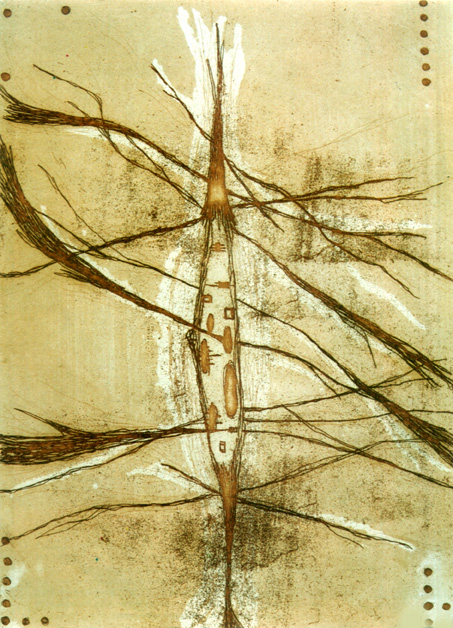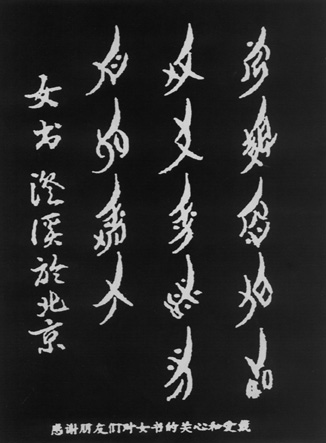The Xiangchu culture 楚湘 1originated in the Province of Hunan 湖南. Recently researches were startled with an unprecedented type of writing. It is called nu shu 女书. 2 The most astonishing characteristic of the nu shu writing is that it has been always restricted to women from the Jiangting 江汀 region, in the District of Jiangyong 江永, South of the present day Province of Hunan.
Nu shu writing can be traced for longer than three-thousand years. It is therefore odd that only recently it has been 'discovered' by specialists. This fact is undoubtedly due to its restrictive use throughout the centuries. Another important factor contributed to both the seclusion and the prerservation of this type of writing: the old traditional cerimony of pactional sisterhood between the 'elected' women. All women who go through this rite of passage must consider henceforth all the other nu shu women 'members' as their sisters. The bond between nu shu sisters is to be stronger and deeper than the affection between natural sisters.
This bond of the nu shu women should be, above all, a sentimental attachment, a kind of 'elevated' friendship and religious fraternity which they share throughout their entire lives. These women reciprocally support themselves in their marriages, daily chores, motherhood afflictions and even grieving their beloved. The origin of nu shu calligraphy derives from such strong and deep social relationship. It was born as a communication device appropriate to 'secretly' convey very personal feelings amongst this group of women. It was, above all, an inacessible tool to men, through which they could express their femininity.
 PREVIOUS PAGE:
Emotions 激情.
MARGARIDA CHEUNG 张美雅
1995. Aquatint etching. 21.4 cm x 30.0 cm.
PREVIOUS PAGE:
Emotions 激情.
MARGARIDA CHEUNG 张美雅
1995. Aquatint etching. 21.4 cm x 30.0 cm.
For centuries now nu shu writing has been particularly used in fans and handkershiefs. These were exclusively given to or exchanged between other nu shu women, which treasured these objects never revealing their mysterious signifiers. Those who decoded to the any noninitiated elements of nu shu calligraphy were severely punished.
The legend says that a woman called Qiu Xiang 秋香 (Autumn Brieze) thaught her husband the code of a nu shu letter. When the other nu shu women found-out about this they composed a song entitled "Censorship to Qiu Xiang" "责秋响书" criticizing their sister's their indiscretion and treason. Another story tells about a girl who allowed her fiancé to convey a nu shu letter of hers to a girl friend. She was heavily critized by her nu shu sisters of this impudent act and forced to break her engagement.
When a women member died all nu shu writings belonging to her were incinerated together with her. They were meant to accompany and assist the deceased in her spiritual future life. This is the reason why so very few testimonies of this type of feminine writing survived to the present.
Nu shu calligraphy was recently unraveled by a joint team of Chinese anthropologists, archeologists and historians. When this scientific delegation started their research in the Jiangyong District they came across three very old women who new about nu shu writing. Their names were: Yi Nianhua 义年华, Gao Yinxian 高银先 and Yang Huanyi 阳焕宜. Alerted of this previously unknown cultural heritage in verge of extinction, the authorities of the Province of Hunan mobilized human and economic resources in an effort to explore and analise to the maximum, and as quickly as poossible, the remainders of this 'mysterious' legacy. The first data of an initial research on nu shu calligraphy was published in a report compiled with academic assistance. Nu shu writing is presently considered a world rarity in the history of Civilizations. Further research is currently under way by a variety of specialists on female studies.
 Frontespiece
In: Feminine Calligraphy by [Wang] Chengxi, in Beijing (Nushu Chengxi prep Beijing) 女书澄溪于北京, title page.
An example of nushu writing.
Frontespiece
In: Feminine Calligraphy by [Wang] Chengxi, in Beijing (Nushu Chengxi prep Beijing) 女书澄溪于北京, title page.
An example of nushu writing.
The earliest found nu shu characters were written with a thin bamboo stick, only later, with the evolution of writing techniques, were ink and brush used. Their graphism is a simple yet decisive linear rendering. It is probable that this incisive writting is associated with the working social status of the nu shu women, healthy in body and mind. The characters are predominantly square, the slight tilt in their composition expressing a delicy and elegance of mannered femininity. In structural terms, nu shu calligraphy is consonant with most of the Chinese archaic writing forms. One single character commonly expresses a plurality of phonetic variations. There are no rigid grammatical rules, the complexity of the compositions varying from the expertise and the fluency of the women author. To decode nu shu writing requires more than a set formula. After its more recent 'discovery', in an attempt to unravel more meaning from the nu shu 'found' writings, a number of linguists concentrated their efforts to systematize and coordinate the lexicon of all its known characters.
Prof. Wang Chengxi王澄溪is presently one of the major specialists in nu shu calligraphy. Her site work in the Jiangyong District was instrumental for the deciphering of the nu shu 'enigma', compiling, classifying, and collating a wealth of 'unknown' material. Her scientific expertise was fundamental for the analytical elaboration of the nu shu stylistic structure. She also composed a number of textual examples in nu shu demonstrating the versatility of this type of written communication. Lately she made contacts with the fifty-four year old He Yanxin何艳新, an inheritor of the nu shu tradition.
He Yanxin was taught nu shu calligraphy by her grandmother early in her adolescence. She vividly remembers a scene from her early years: her grandmother together with other country women seated around a tree, singing and writing in nu shu. She says that learning nu shu was easy. The elderly ladies first taught her how to sing traditional nu shu songs, only after being initiated to the calligraphy's writing skills. She developed her writing fluency with the help of three manuscript volumes which the other nu shu sisters had offered to her grandmother as a wedding present.
Once proficient in nu shu writing, He Yanxin herself tried composing new short texts. Her works express the joy of living and popular attitudes. For instance, in one of her compositions she describes a group of women labourers getting along with their daily tasks with the help of a nu shu song — typical for its rythm and cadence —: "First, take as an example the shape of the increasing moon; then, lions swirling embroidered balls; and thirdly, the celebration of the three friends' pact under the peach tree."3 In another example she engenders a riddle about the moon: "It does not seed spring; it does not flower in the four seasons; she gives us, either a banana or a watermelon." Her naive compositions express a lifestyle in close contact with nature. Their enchantment directly derives from this earthly simplicity.
Nu shu calligraphy is foremost relevant as the expression of the feminine position in a rural society; of women who developed a particularly creative communication medium maintaining its traditional codified usage throughout the centuries.
Retranslated from a Portuguese translation of the original Chinese by: Rita Camacho
CHINESE GLOSSARY
Gao Yinxian 高银先
Guan Yu 关羽
He Yanxin 何艳新
Hunan 湖南
Jiangting 江汀
Jiangyong 江永
Liu Bei 刘备
nu shu 女书
Qiu Xiang 秋香
Special Training High School of Shaoyang 邵阳高等专科学校 Shaoyang Gaodeng Zhuanke Xuexiao
Shaoyang 邵阳
Xiangchu 楚湘
Wang Chengxi 王澄溪
Yan Nong 严农
Yang Huanyi 阳焕宜
Yi Nianhua 义年华
"Ze Qiu Xiang Shu" 责秋响书
Zhang Fei 张飞
NOTES
1A traditional regional Chinese culture which approximately corresponds to the contemporary boundaries of the Province of Hunan.
2Nu =女Woman, female. Shu =书Writing, to write, any written testimony.
The compound nu+shu[女+书] is, in this particular context, the writing and 'language' ancestrally structured by the women of the Jiangting region.
3"[…] the three friends' pact under the peach tree", make reference to a popular Chinese folk tale.
During the Period of the Three Kingdoms (AD220-280), Liu Bei 刘备— of Royal descent, Guan Yu 关羽— errand knight, and Zhang Fei张飞— country hero, happened to meet. They became such good friends that from there onwards were seen always together having celebrated between themselves an alliance pact to fight the common enemy.
*Journalist at the Special Training High School of Shaoyang, Shaoyang, Province of Hunan.
start p. 25
end p.